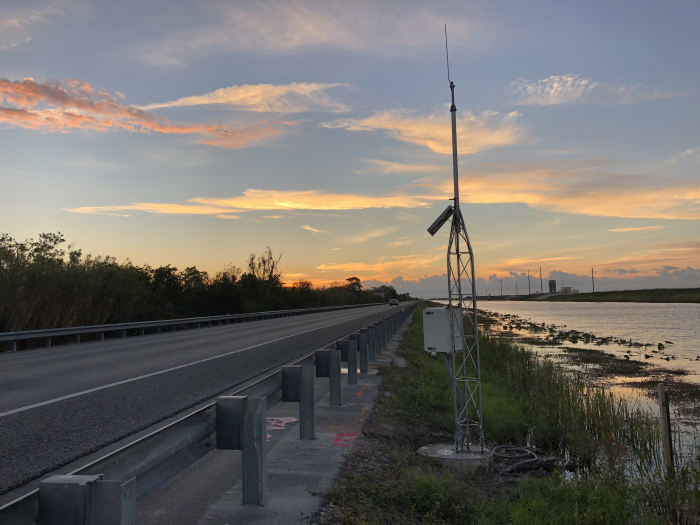




エバーグレーズ国立公園は、米国最大の熱帯自然保護区で、南フロリダの湿地帯の脆弱な生態系を保護するために設立されました。この公園は、世界遺産、生物圏保護区、国際的に重要な湿地帯として同時に登録されている世界 3 か所のうちの 1 つです。エバーグレーズはビスケーン帯水層の涵養地帯の上にあり、南フロリダの淡水供給の大部分の源となっています。
1920 年代にフロリダ州マイアミの西に米国ハイウェイ 41 (「タミアミ トレイル」) が建設される前は、淡水はフロリダ州を南に自由に流れ、エバーグレーズの湿地帯に水を供給していました。タミアミ トレイルは実質的に水の流れを遮断し、水はマイアミやその他の近隣の都市に転用され、農業や住宅用に沼地を排水する計画が立てられました。公園内の淡水の水位が下がると、塩水が侵入し、エバーグレーズの生態系が損なわれ、公園内の生物多様性に悪影響を及ぼします。公園の生態系の保護に費やされた 1 ドルごとに 4 ドルの利益がもたらされると推定されています。
消滅しつつあるエバーグレーズを守るため、1930 年代から 1940 年代にかけて、大規模な運河建設プロジェクトが始まりました。これには、上流の真水を公園に供給するタミアミ トレイルに隣接する運河も含まれます。運河の水位が高いことは、暗渠や橋の下からエバーグレーズに水を押し出すために不可欠ですが、道路の基礎を損傷し、自動車運転者に危険を及ぼす可能性もあります。高速道路の損傷を防ぐため、フロリダ州運輸局 (DOT) は運河の水位を 7.0 フィート (NAVD88) に制限しています。このように、高い水位を維持しながら道路の基礎を保護するという絶妙なバランスが保たれています。
RESPEC は、タミアミ トレイル沿いに公園の 6 つの監視サイトを設置し、運河の水位、道路基盤近くの地下土壌の水位、道路基盤の下の土壌水分量を監視しました。センサーには、Amazon バブラー、Geokon バイブレーティングワイヤ ピエゾメーター、Campbell Scientific CS650 土壌水分プローブ、および UT10 タワーの Campbell エンクロージャに取り付けられた CS100 気圧センサーが含まれます。タワーはハリケーン級の強風に耐えられるように構築されており、CAD 溶接で接地されています。データは、Campbell Scientific CR300-CELL205 データロガーによって 15 分間隔で収集され、携帯電話リンクを介して 1 時間に 1 回 Eagle.io Web ダッシュボードに送信され、関係者はここでデータを表示およびダウンロードできます。リアルタイム システムでは、現在の水と土壌の水分レベルが事前に設定されたしきい値を超えると、電子メールまたはテキスト通知が送信されます。同様に、このシステムにより、エバーグレーズ国立公園局とフロリダ州運輸省は適切な対応を調整できます。